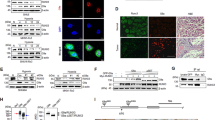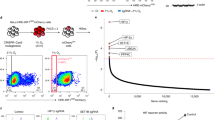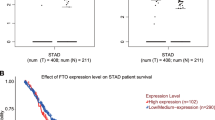Abstract
RUNX3 is a tumor suppressor that is silenced in cancer following hypermethylation of its promoter. The effects of hypoxia in tumor suppressor gene (TSG) transcription are largely unknown. Here, we investigated hypoxia-induced silencing mechanisms of RUNX3. The expression of RUNX3 was downregulated in response to hypoxia in human gastric cancer cells at the transcriptional level. This downregulation was abolished following treatment with the histone deacetylase (HDAC) inhibitor trichostatin A (TSA) and cytosine methylation inhibitor 5-aza-2-deoxycytidine (5-Aza), suggesting that an epigenetic regulatory mechanism may be involved in RUNX3 silencing by hypoxia. DNA methylation PCR and bisulfite-sequencing data revealed that hypoxia did not affect the methylation of RUNX3 promoter. A chromatin immunoprecipitation (ChIP) assay revealed increased histone H3-lysine 9 dimethylation and decreased H3 acetylation in the RUNX3 promoter following hypoxia. Hypoxia resulted in the upregulation of G9a histone methyltransferase (HMT) and HDAC1; additionally, overexpression of G9a and HDAC1 attenuated RUNX3 expression. The overexpression of G9a and HDAC1, but not their mutants, inhibited the nuclear localization and expression of RUNX3. Diminished mRNA expression and nuclear localization of RUNX3 during hypoxia was abolished by siRNA-mediated knockdown of G9a and HDAC1. This study suggests that hypoxia silences RUNX3 by epigenetic histone regulation during the progression of gastric cancer.
This is a preview of subscription content, access via your institution
Access options
Subscribe to this journal
Receive 50 print issues and online access
$259.00 per year
only $5.18 per issue
Buy this article
- Purchase on Springer Link
- Instant access to full article PDF
Prices may be subject to local taxes which are calculated during checkout






Similar content being viewed by others

References
Anderson C, Nijagal A, Kim J . (2006). Molecular markers for gastric adenocarcinoma: an update. Mol Diagn Ther 10: 345–352.
Bachman KE, Park BH, Rhee I, Rajagopalan H, Herman JG, Baylin SB et al. (2003). Histone modifications and silencing prior to DNA methylation of a tumor suppressor gene. Cancer Cell 3: 89–95.
Bae SC, Lee YH . (2006). Phosphorylation, acetylation and ubiquitination: the molecular basis of RUNX regulation. Gene 366: 58–66.
Baylin SB, Herman JG . (2000). DNA hypermethylation in tumorigenesis: epigenetics joins genetics. Trends Genet 16: 168–174.
Box AH, Demetrick DJ . (2004). Cell cycle kinase inhibitor expression and hypoxia-induced cell cycle arrest in human cancer cell lines. Carcinogenesis 25: 2325–2335.
Bunn HF, Poyton RO . (1996). Oxygen sensing and molecular adaptation to hypoxia. Physiol Rev 76: 839–885.
Chan AO, Lam SK, Wong BC, Kwong YL, Rashid A . (2003). Gene methylation in non-neoplastic mucosa of gastric cancer: age or Helicobacter pylori related? Am J Pathol 163: 370–371.
Chen H, Yan Y, Davidson TL, Yoichi S, Costa M . (2006). Hypoxia stress induces dimethylated histone H3 lysine 9 through histone methyltranstrease G9a in mammalian cells. Cancer Res 66: 9009–9016.
Durst KL, Hiebert SW . (2004). Role of RUNX family members in transcriptional repression and gene silencing. Oncogene 23: 4220–4224.
Ekstrom AM, Held M, Hansson LE, Engstrand L, Nyren O . (2001). Helicobacter pylori in gastric cancer established by CagA immunoblot as a marker of past infection. Gastroenterology 121: 784–791.
Esteban MA, Tran MG, Harten SK, Hill P, Castellanos MC, Chandra A et al. (2006). Regulation of E-cadherin expression by VHL and hypoxia-inducible factor. Cancer Res 66: 3567–3575.
Fahrner JA, Eguchi S, Herman JG, Baylin SB . (2002). Dependence of histone modifications and gene expression on DNA hypermethylation in cancer. Cancer Res 62: 7213–7218.
Gibbons RJ (2005). Histone modifying and chromatin remodelling enzymes in cancer and dysplastic syndromes. Hum Mol Genet 14: R85–R92.
Harris AL . (2002). Hypoxia—a key regulatory factor in tumour growth. Nat Rev Cancer 2: 38–47.
Herman JG, Graff JR, Myöhänen S, Nelkin BD, Baylin SB . (1996). Methylation-specific PCR: a novel PCR assay for methylation status of CpG islands. Proc Natl Acad Sci USA 93: 9821–9826.
Huang C, Ida H, Ito K, Zhang H, Ito Y . (2007). Contribution of reactivated RUNX3 to inhibition of gastric cancer cell growth following suberoylanilide hydroxamic acid (vorinostat) treatment. Biochem Pharmacol 73: 990–1000.
Ito K, Liu Q, Salto-Tellez M, Yano T, Tada K, Ida H et al. (2005). RUNX3, a novel tumor suppressor, is frequently inactivated in gastric cancer by protein mislocalization. Cancer Res 65: 7743–77450.
Ivanov SV, Salnikow K, Ivanova AV, Bai L, Lerman MI . (2007). Hypoxic repression of STAT1 and its downstream genes by a pVHL/HIF-1 target DEC1/STRA13. Oncogene 26: 802–812.
Jin YH, Jeon EJ, Li QL, Lee YH, Choi JK, Kim WJ et al. (2004). Transforming growth factor-beta stimulates p300-dependent RUNX3 acetylation, which inhibits ubiquitination-mediated degradation. J Biol Chem 279: 29409–29417.
Johnson EN, Lee YM, Sander TL, Rabkin E, Schoen FJ, Kaushal S et al. (2003). NFATc1 mediates vascular endothelial growth factor-induced proliferation in human pulmonary valve endothelial cells. J Biol Chem 278: 1686–1692.
Johnstone RW . (2002). Histone-deacetylase inhibitors: novel drugs for the treatment of cancer. Nat Rev Drug Discov 1: 287–299.
Jones PA, Baylin SB . (2007). The epigenomics of cancer. Cell 128: 683–692.
Jones PL, Veenstra GJ, Wade PA, Vermaak D, Kass SU, Landsberger N et al. (1998). Methylated DNA and MeCP2 recruit histone deacetylase to repress transcription. Nat Genet 19: 187–191.
Kim MS, Kwon HJ, Lee YM, Baek JH, Jang JE, Lee SW et al. (2001). Histone deacetylases induce angiogenesis by negative regulation of tumor suppressor genes. Nat Med 7: 437–443.
Krishnamachary B, Zagzag D, Nagasawa H, Rainey K, Okuyama H, Baek JH et al. (2006). Hypoxia-inducible factor-1-dependent repression of E-cadherin in von Hippel-Lindau tumor suppressor-null renal cell carcinoma mediated by TCF3, ZFHX1A, and ZFHX1B. Cancer Res 66: 2725–2731.
Li QL, Ito K, Sakakura C, Fukamachi H, Inoue K, Chi XZ et al. (2002). Causal relationship between the loss of RUNX3 expression and gastric cancer. Cell 109: 113–124.
Li QL, Kim HR, Kim WJ, Choi JK, Lee YH, Kim HM et al. (2004). Transcriptional silencing of the RUNX3 gene by CpG hypermethylation is associated with lung cancer. Biochem Biophys Res Commun 314: 223–228.
Liu Y, Oakeley EJ, Sun L, Jost JP . (1998). Multiple domains are involved in the targeting of the mouse DNA methyltransferase to the DNA replication foci. Nucleic Acids Res 26: 1038–1045.
Meng AX, Jalali F, Cuddihy A, Chan N, Bindra RS, Glazer PM et al. (2005). Hypoxia down-regulates DNA double strand break repair gene expression in prostate cancer cells. Radiother Oncol 76: 168–176.
Mihaylova VT, Bindra RS, Yuan J, Campisi D, Narayanan L, Jensen R et al. (2003). Decreased expression of the DNA mismatch repair gene Mlh1 under hypoxic stress in mammalian cells. Mol Cell Biol 23: 3265–3273.
Momparler RL . (2002). Cancer epigenetics. Oncogene 22: 6479–6483.
Nan X, Campoy FJ, Bird A . (1997). MeCP2 is a transcriptional repressor with abundant binding sites in genomic chromatin. Cell 88: 471–481.
Nan X, Ng HH, Johnson CA, Laherty CD, Turner BM, Eisenman RN et al. (1998). Transcriptional repression by the methyl-CpG-binding protein MeCP2 involves a histone deacetylase complex. Nature 393: 386–389.
Nguyen CT, Weisenberger DJ, Velicescu M, Gonzales FA, Lin JC, Liang G et al. (2002). Histone H3-lysine 9 methylation is associated with aberrant gene silencing in cancer cells and is rapidly reversed by 5-aza-2′-deoxycytidine. Cancer Res 62: 6456–6461.
Nielsen SJ, Schneider R, Bauer UM, Bannister AJ, Morrison A, O'Carroll D et al. (2001). Rb targets histone H3 methylation and HP1 to promoters. Nature 412: 561–565.
Okano M, Bell DW, Haber DA, Li E . (1999). DNA methyltransferases Dnmt3a and Dnmt3b are essential for de novo methylation and mammalian development. Cell 99: 247–257.
Robertson KD, Ait-Si-Ali S, Yokochi T, Wade PA, Jones PL, Wolffe AP . (2000). DNMT1 forms a complex with Rb, E2F1 and HDAC1 and represses transcription from E2F-responsive promoters. Nat Genet 25: 338–342.
Robertson KD, Uzvolgyi E, Liang G, Talmadge C, Sumegi J, Gonzales FA et al. (1999). The human DNA methyltransferases (DNMTs) 1, 3a and 3b: coordinate mRNA expression in normal tissues and overexpression in tumors. Nucleic Acids Re 27: 2291–2298.
Semenza GL . (2003). Angiogenesis in ischemic and neoplastic disorders. Annu Rev Med 54: 17–28.
Shaw J, Zhang T, Rzeszutek M, Yurkova N, Baetz D, Davie JR et al. (2006). Transcriptional silencing of the death gene BNIP3 by cooperative action of NF-kappaB and histone deacetylase 1 in ventricular myocytes. Circ Res 99: 1347–1354.
Takebayashi S, Nakao M, Fujita N, Sado T, Tanaka M, Taguchi H et al. (2001). 5-Aza-2′-deoxycytidine induces histone hyperacetylation of mouse centromeric heterochromatin by a mechanism independent of DNA demethylation. Biochem Biophys Res Commun 288: 921–926.
Tamaru H, Selker EU . (2003). Synthesis of signals for de novo DNA methylation in Neurospora crassa. Mol Cell Biol 23: 2379–2394.
Uemura N, Okamoto S, Yamamoto S, Matsumura N, Yamaguchi S, Yamakido M et al. (2001). Helicobacter pylori infection and the development of gastric cancer. N Engl J Med 345: 784–789.
Ushijima T, Sasako M . (2004). Focus on gastric cancer. Cancer Cell 5: 121–125.
Wade PA, Gegonne A, Jones PL, Ballestar E, Aubry F, Wolffe AP . (1999). Mi-2 complex couples DNA methylation to chromatin remodelling and histone deacetylation. Nat Genet 23: 62–66.
Wei D, Gong W, Oh SC, Lo Q, Kim WD, Wang L et al. (2005). Loss of RUNX3 expression significantly affects the clinical outcome of gastric cancer patients and its restoration causes drastic suppression of tumor growth and metastasis. Cancer Res 65: 4809–4816.
Yoder JA, Soman NS, Verdine GL, Bestor TH . (1997). DNA (cytosine-5)-methyltransferases in mouse cells and tissues. Studies with a mechanism-based probe. J Mol Biol 270: 385–395.
Acknowledgements
Expression vectors of full-length HDAC1 and HDAC1 mutants were kindly provided by Dr Kyu-Won Kim (Seoul National University), GFP-tagged human G9a expression vector, pEGFP-hG9a, and its SET domain deletion mutant, pEGFP-hG9a (ΔSET) were by Martin Walsh (Mount Sinai School of Medicine, New York, NY, USA) and myc-tagged RUNX3 plasmids in pCS4 was by Dr Suk-Chul Bae (Chungbuk National University, Korea). This work was supported by National R&D Program for Cancer Control, Ministry of Health and Welfare (0520120-1) and the Korea Science and Engineering Foundation (KOSEF) grant funded by the Korea government (MOST; R01-2006-000-11046-0).
Author information
Authors and Affiliations
Corresponding author
Rights and permissions
About this article
Cite this article
Lee, S., Kim, J., Kim, WH. et al. Hypoxic silencing of tumor suppressor RUNX3 by histone modification in gastric cancer cells. Oncogene 28, 184–194 (2009). https://doi.org/10.1038/onc.2008.377
Received:
Revised:
Accepted:
Published:
Issue Date:
DOI: https://doi.org/10.1038/onc.2008.377
Keywords
This article is cited by
-
Tumor-suppressive functions of protein lysine methyltransferases
Experimental & Molecular Medicine (2023)
-
Calreticulin enhances gastric cancer metastasis by dimethylating H3K9 in the E-cadherin promoter region mediating by G9a
Oncogenesis (2022)
-
PARP3 supervises G9a-mediated repression of adhesion and hypoxia-responsive genes in glioblastoma cells
Scientific Reports (2022)
-
RUNX3 methylation drives hypoxia-induced cell proliferation and antiapoptosis in early tumorigenesis
Cell Death & Differentiation (2021)
-
Effect of circular RNA, mmu_circ_0000296, on neuronal apoptosis in chronic cerebral ischaemia via the miR-194-5p/Runx3/Sirt1 axis
Cell Death Discovery (2021)


